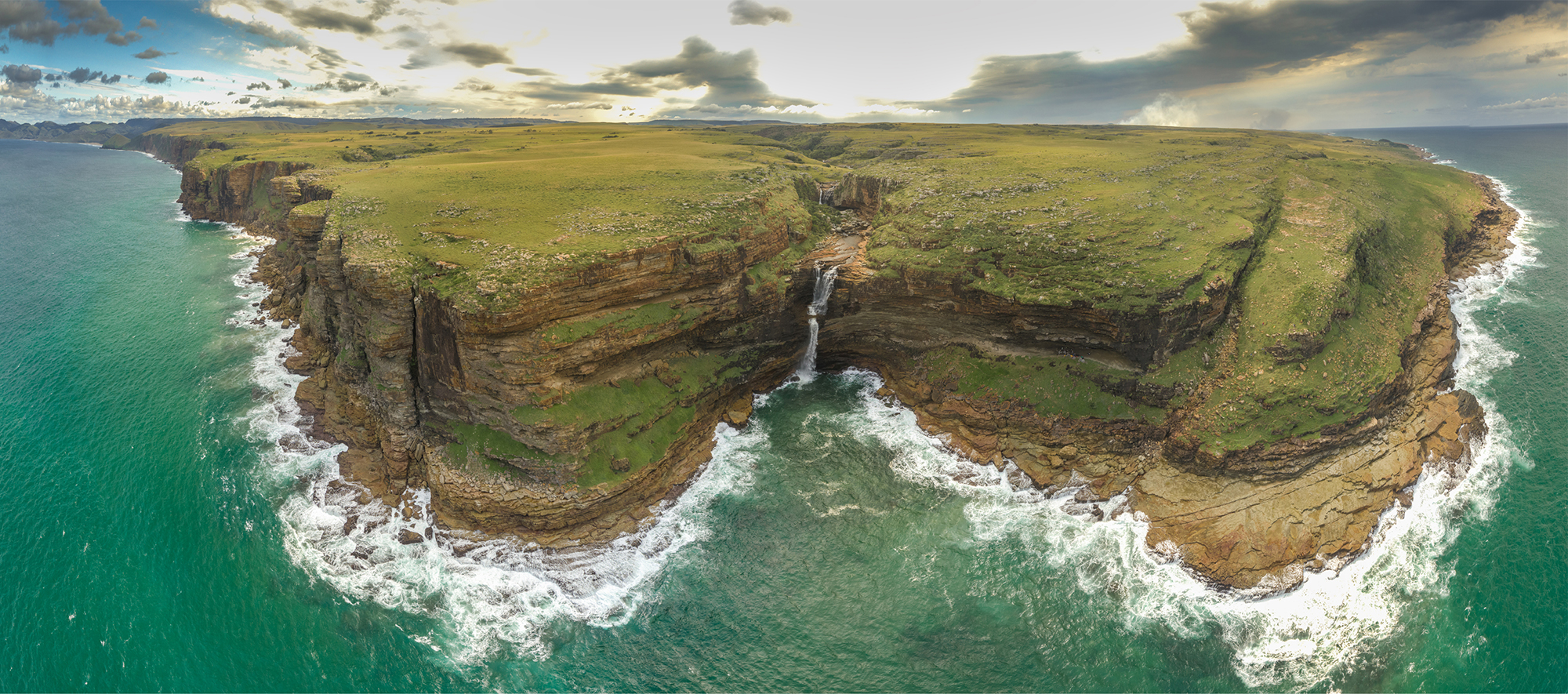In Pondoland, on the east coast of South Africa, Erich Fisher, an Institute of Human Origins research scientist, has been leading research at the Waterfall Bluff rock shelter on the edge of the Indian Ocean. The site is beautiful and remote — just the place that interested producers of the Discovery Channel program “Expedition Unknown” for their series on human origins, which will air Wednesday, Feb. 26, as the finale for their current season.
For nearly 20 years, the Institute of Human Origins has had a research site on the south coast of South Africa at Mossel Bay, under the direction of Curtis Marean, associate director of the institute and Foundation Professor with Arizona State University's School of Human Evolution and Social Change. Fisher was a long-term member of Marean’s research team, and it was their cutting-edge research in Mossel Bay that led him to Pondoland.
Mossel Bay, like most of the South African coastline, is located next to a very broad undersea continental shelf. When sea levels dropped during glacial periods, coastal places like Mossel Bay became inland places, sometimes over 50 miles away from the ocean. If people wanted to gather sea foods during those times, they had to travel out onto the exposed shelf. When sea levels rose 11,000 years ago, it submerged the continental shelf, destroying the evidence of glacial coastal occupations. In Pondoland, however, there is a narrow continental shelf, and the coastlines have remained practically the same since glacial periods. Fisher thought that this may have preserved evidence of glacial human occupation that was not available at Mossel Bay.
Researcher Erich Fisher's work in South Africa aims to be inclusive; his team consists of students from all the major universities in South Africa, as well as Lesotho, Cameroon and Zimbabwe. Photo courtesy of Erich Fisher
Fisher and his team have been working in Pondoland since 2011, excavating at Waterfall Bluff since 2015. Last year, his team discovered the first direct evidence in Africa of coastal foraging during the Last Glacial Maximum, which lasted from 26,500 years ago to 19,000 years ago, when sea levels were at their lowest. During this time, many inland areas across southern Africa were abandoned due to the rapid climatic changes, yet Fisher’s research has shown that people at Waterfall Bluff were collecting shellfish and fishing in the ocean from 35,000 years ago to 11,000 years ago, spanning the glacial maximum and the shift from the Pleistocene to the Holocene.
“When the producers of the show contacted us, it was all so timely,” Fisher said. “They wanted to highlight cutting-edge research on human adaptations in remote, picturesque places. Here, we had just found amazing new evidence of coastal foraging, which no one had ever seen before, in a rock shelter with a 200-foot-high waterfall, next to the Indian Ocean. The timing was perfect.”
In addition to the field research in this sparsely inhabited area of South Africa, Fisher and his multidisciplinary and international team have also developed numerous initiatives to support diversity and inclusivity within the archaeological sciences. Over half of Fisher’s team are based at African institutions, and the 2019 field season included students from all major research institutions in South Africa, as well as from universities in Zimbabwe, Lesotho and Cameroon, providing a rich cultural learning experience for ASU students who also participate.
An aerial view of the research site, which has a very narrow continental shelf. Photo courtesy Erich Fisher
Fisher and his team also engage in grassroots efforts to support education and cultural and natural heritage preservation in the local community. Since 2015, they have run an indigenous cultural heritage training program in partnership with the East London (South Africa) Museum, South African government agencies, and local Amapondo communities. The program supports local economic development through ecotourism and creates liaisons with government officials to manage and preserve cultural heritage in Pondoland.
They also recently received a grant to develop a multilingual comic book that uses indigenous Amapondo examples and people to teach primary and secondary school students about multidisciplinary archaeological sciences and their local natural and cultural heritage, and provide them with resources about attending higher education.
During the conclusion of filming, Fisher’s team organized a communitywide traditional celebration at the local chief’s residence and community center, bringing together their field team, film crew and the community in a celebration of Amapondo music, dancing and food.
“When I started telling the TV producers about Pondoland — the waterfalls, canyons, wildlife — I could tell immediately that they didn’t believe me. Photographs just don’t do the area justice,” Fisher said. “But, Pondoland and the people who have lived there from the past to today are that special and unique, and the place deserves to be recognized. So, it made me chuckle every time we would turn a corner or walk over a hill and someone on the film crew would fall over themselves to get some ‘amazing’ new shot.
"Opportunities like this are so important to scientific projects like ours, not just because it is fun, but because it lets us raise awareness to a global audience about important issues relating to human origins and adaptations, nature and wildlife conservation, and the insights these studies provide about our future and the effects of climate changes today.”
Top video courtesy of Erich Fisher
More Science and technology

ASU-led space telescope is ready to fly
The Star Planet Activity Research CubeSat, or SPARCS, a small space telescope that will monitor the flares and sunspot activity of low-mass stars, has now passed its pre-shipment review by NASA.…

ASU at the heart of the state's revitalized microelectronics industry
A stronger local economy, more reliable technology, and a future where our computers and devices do the impossible: that’s the transformation ASU is driving through its microelectronics research…

Breakthrough copper alloy achieves unprecedented high-temperature performance
A team of researchers from Arizona State University, the U.S. Army Research Laboratory, Lehigh University and Louisiana State University has developed a groundbreaking high-temperature copper alloy…




